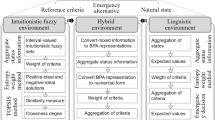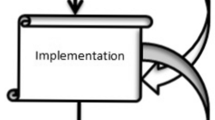Abstract
In this paper, a robust and consistent COVID-19 emergency decision-making approach is proposed based on q-rung linear diophantine fuzzy set (q-RLDFS), differential evolutionary (DE) optimization principles, and evidential reasoning (ER) methodology. The proposed approach uses q-RLDFS in order to represent the evaluating values of the alternatives corresponding to the attributes. DE optimization is used to obtain the optimal weights of the attributes, and ER methodology is used to compute the aggregated q-rung linear diophantine fuzzy values (q-RLDFVs) of each alternative. Then the score values of alternatives are computed based on the aggregated q-RLDFVs. An alternative with the maximum score value is selected as a better one. The applicability of the proposed approach has been illustrated in COVID-19 emergency decision-making system and sustainable energy planning management. Moreover, we have validated the proposed approach with a numerical example. Finally, a comparative study is provided with the existing models, where the proposed approach is found to be robust to perform better and consistent in uncertain environments.
Similar content being viewed by others
References
Z Wu, J M McGoogan. Characteristics of and important lessons from the coronavirus disease 2019 (COVID-19) outbreak in china: summary of a report of 72 314 cases from the Chinese Center for Disease Control and Prevention, Jama, 2020, 323(13): 1239–1242.
S Ashraf, S Abdullah. Emergency decision support modeling for COVID-19 based on spherical fuzzy information, International Journal of Intelligent Systems, 2020, 35(11): 1601–1645.
S Ashraf, S Abdullah, A O Almagrabi. A new emergency response of spherical intelligent fuzzy decision process to diagnose of COVID19, Soft Computing, 2023, 27(3): 1809–1825.
World Health Organization. Global surveillance for COVID-19 disease caused by human infection with the 2019 novel coronavirus, Interim guidance, 2020.
J F W Chan, S Yuan, K H Kok, et al. A familial cluster of pneumonia associated with the 2019 novel coronavirus indicating person-to-person transmission: a study of a family cluster, Lancet, 2020, 395(10223): 514–523.
F Yu, L Du, D M Ojcius, et al. Measures for diagnosing and treating infections by a novel coronavirus responsible for a pneumonia outbreak originating in Wuhan, China, Microbes and Infection, 2020, 22(2): 74–79.
M Riaz, M R Hashmi, H Kalsoom, et al. Linear Diophantine Fuzzy Soft Rough Sets for the Selection of Sustainable Material Handling Equipment, Symmetry, 2020, 12(8): 1215.
S M Chen, C H Chiou. Multiattribute Decision Making Based on Interval-Valued Intuitionistic Fuzzy Sets, PSO Techniques, and Evidential Reasoning Methodology, IEEE Transactions on Fuzzy Systems, 2015, 23(6): 1905–1916.
M Riaz, M R Hashmi. Linear Diophantine fuzzy set and its applications towards multi-attribute decision making problems, Journal of Intelligent & Fuzzy Systems, 2019, 37(4): 5417–5439.
A O Almagrabi, S Abdullah, M Shams, et al. A new approach to q-linear Diophantine fuzzy emergency decision support system for COVID19, Journal of Ambient Intelligence and Humanized Computing, 2022, 13: 1687–1713.
R Storn, K Price. Differential Evolution–A Simple and Efficient Heuristic for Global Optimization over Continuous Spaces, Journal of Global Optimization, 1997, 11: 341–359.
J B Yang. Rule and utility based evidential reasoning approach for multi-attribute decision analysis under uncertainty, European Journal of Operational Research, 2001, 131(1): 31–61.
L A Zadeh. Fuzzy sets, Information and Control, 1965, 8: 338–353.
K T Atanassov. More on intuitionistic fuzzy sets, Fuzzy Sets and Systems, 1989, 33: 37–45.
P Liu, P Wang. Some q-rung orthopair fuzzy aggregation operators and their applications to multiple-attribute decision making, International Journal of Intelligent Systems, 2018, 33: 259–280.
R R Yager. Generalized orthopair fuzzy sets, IEEE Transactions on Fuzzy Systems, 2016, 25: 1222–1230.
J B Yang, D L Xu. On the evidential reasoning algorithm for multiple attribute decision analysis under uncertainty, IEEE Transactions on Systems, 2002, 32(3): 289–304.
J B Yang. Rule and utility based evidential reasoning approach for multiattribute decision analysis under uncertainties, European Journal of Operational Research, 2001, 131(1): 31–61.
P Melin, J C Monica, D Sanchez, et al. Multiple Ensemble Neural Network Models with Fuzzy Response Aggregation for Predicting COVID19 Time Series: The Case of Mexico, Healthcare, 2020, 8: 181.
T Sun, Y Wang. Modeling COVID-19 epidemic in Heilongjiang province, Chaos, Solitons and Fractals, 2020, 138: 109949.
O Castillo, P Melin. Forecasting of COVID-19 time series for countries in the world based on a hybrid approach combining the fractal dimension and fuzzy logic, Chaos, Solitons and Fractals, 2020, 140: 110242.
O Castillo, P Melin. A Novel Method for a COVID-19 Classification of Countries Based on an Intelligent Fuzzy Fractal Approach, Healthcare, 2021, 9(2): 196.
A Si, S Das, S Kar. Picture fuzzy set-based decision-making approach using Dempster-Shafer theory of evidence and grey relation analysis and its application in COVID-19 medicine selection, Soft Computing, 2023, 27(6): 3327–3341.
G P Chander, S Das. Decision Making Using Interval-Valued Pythagorean Fuzzy Set-Based Similarity Measure, In Intelligent Computing and Communication Systems, Springer, Singapore, 2021, 269–277.
G P Chander, S Das. Multi-attribute decision making using interval-valued pythagorean fuzzy set and differential evolutionary algorithm, 2021 IEEE International Conference on Fuzzy Systems, Luxembourg, 2021, 1–6.
O Castillo, P Melin. A new fuzzy fractal control approach of non-linear dynamic systems: The case of controlling the COVID-19 pandemics, Chaos, Solitons and Fractals, 2021, 151: 111250.
P Melin, O Castillo. Spatial and Temporal Spread of the COVID-19 Pandemic Using Self Organizing Neural Networks and a Fuzzy Fractal Approach, Sustainability, 2021, 13(15): 8295.
S Ayub, M Shabir, M Riaz, et al. Linear Diophantine Fuzzy Relations and Their Algebraic Properties with Decision Making, Symmetry, 2021, 13(6): 945.
Author information
Authors and Affiliations
Corresponding authors
Ethics declarations
Conflict of interest The authors declare no conflict of interest.
Rights and permissions
About this article
Cite this article
Chander, G.P., Das, S. COVID-19 emergency decision-making using q-rung linear diophantine fuzzy set, differential evolutionary and evidential reasoning techniques. Appl. Math. J. Chin. Univ. 40, 182–206 (2025). https://doi.org/10.1007/s11766-025-4550-0
Received:
Revised:
Published:
Issue Date:
DOI: https://doi.org/10.1007/s11766-025-4550-0
Keywords
- COVID-19
- q-rung linear diophantine fuzzy set
- differential evolutionary
- evidential reasoning
- decision-making




